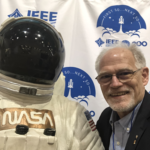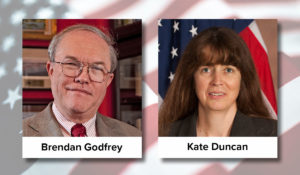
Your vote in the IEEE Elections does make a difference. Some IEEE elections have been decided by only a few votes and one of the deciding votes could be yours. In many cases there are real differences in the views, objectives and personalities of various IEEE candidates and this is your opportunity to help select who will lead our professional organization in the next few years. Just like in national and local political elections, your vote matters.
IEEE Elections started on 15 August and will continue until 1 October 2019. There are candidates for many positions, including IEEE President-elect, IEEE-USA President-elect and for both geographic as well as technical activities representation. In addition, many IEEE technical societies and the IEEE Standards Association are now conducting elections for officers.
Locally, your IEEE Section and Chapters are probably getting ready for their own elections, that will begin in the Fall. The greatest value for many of our members is when they get engaged with other IEEE people. Now is the time to consider whether you would like to help lead some part of IEEE and develop your own leadership skills, meet more IEEE volunteers and help us keep our professional home vibrant and cool and take IEEE into the future. Consider putting your name in for a local IEEE office, or for some part of the larger IEEE organization.
I know that I have gained much from my experiences as an IEEE volunteer leader. I have been involved in local technical chapters and my sections, IEEE societies, IEEE Sections Congress, IEEE Standards, MGA and IEEE-USA, as well as leading and being a member of several IEEE committees over the years. It has been a wonderful experience and has given me many chances to meet and work with great IEEE volunteers. I hope that I have been able to energize IEEE activities in the offices I have had the honor to fill, for that was my intent. Perhaps you will consider volunteering some of your time to run for and trying out IEEE leadership positions. It can be very rewarding.
Following is more information on the 2019 IEEE higher office elections (many of these people will sit on the IEEE Board of Directors): Information about the candidates and access to your ballot is available electronically on the IEEE Annual Election Site at www.ieee.org/elections. You will need your IEEE Account (username and password) to authenticate access. If you requested a paper ballot, it has been mailed to you, should you prefer to return your ballot via postal mail. Completed ballots will be accepted until 12:00 pm Eastern Time (16:00 UTC) on 1 October 2019.
When accessing your ballot electronically, you may save your choices at any point by clicking “Logout” and return later to cast your vote. For your vote to count, be sure to click the “Submit Ballot” button on the ballot summary page. After your ballot is submitted, you will receive an email confirmation. Once you have submitted your ballot, please take a minute to complete the online feedback form and let us know about your voting experience. If you have any questions, contact DirectVote support or call +1 952 974 2339.
Thanks for your attention and remember to vote in 2019 IEEE Elections!

Tom Coughlin
IEEE-USA President, 2019
| |








Why is it important to vote when many U.S. born IEEE-USA members feel IEEE-USA no longer truly represents them? Could this be one contributing factor of many why U.S. membership is declining? When IEEE-USA candidates discuss diversity, they are usually speaking in terms of immigration diversity. What happened to hiring American STEM professionals of ALL ethnicities, ages, and genders instead of increasing employment based immigration?
Many American STEM professionals were forced out of the profession they loved by age discrimination (disguised as “not a good corporate cultural fit”), H-1B, L-1, F1 OPT, (and possibly H4 EAD) visa workers, and offshoring. These additional reasons why American STEM professionals left the IEEE.
Mr. Roberts,
Thank you for reading my blog and for sharing your comments. I share your concerns about temporary visas and age discrimination. IEEE-USA has been a leading voice in Washington fighting for H-1B and L visa reform since the 1990’s. We successfully rolled back an H-1B expansion in 2004 and defeated legislative proposals to expand the program every year since. This year we helped successfully add H-1B reform language to legislation that is likely to pass Congress. I know these efforts have not fixed the problem, but we continue to work to educate legislators about the impact visa programs have on America’s technology workforce. While much of our work is hard to see, I assure you we consider the fight to be one of our top legislative priorities.
But to me, “Diversity” is much bigger than immigration. It means inviting students of all backgrounds to consider engineering as a profession, and ensuring that our profession is welcoming to all of those students who wish to join us.
When I first entered this field, way back when Silicon Valley was still the Santa Clara Valley, engineering was seen as a profession where poorer kids, immigrant kids, and kids without connections could work hard and get good jobs that cemented them into the American Middle class – unlike medicine, law and some other fields that were much harder to access. This was not only how people perceived engineering – it was also mostly true. Engineering was open to people who were willing to work hard enough, regardless of where they came from.
Of course “people” didn’t usually include women and frequently didn’t include ethnic minorities, but for the time, engineering was still a relatively accessible profession.
I think that two things have now changed. First, we now recognize that being accessible to “many” people is not good enough. Engineering needs to be accessible to everyone. I am proud that IEEE and IEEE-USA are leading efforts to combat harassment and discrimination within our profession (including age discrimination), and I intend to continue to promote those efforts.
Second, I fear that our society has forgotten how accessible and enabling engineering is. There are entire communities within the United States that produce almost no engineers and don’t understand the opportunities from being an engineer. Children in inner cities, poorer neighborhoods and even rural communities (traditionally the source of many of our best engineers) don’t see engineering as a viable profession for them. This is a real loss – to both the United States and to the engineering community.
When I say “diversity” I do include immigration, but the term is much bigger than that. I mean telling kids in poor schools that they can become a professional engineer. I mean changing our professional culture to welcome all professionals, regardless of age, race and gender. And I mean inviting talented, hardworking individuals to join us as equals, no matter where they come from.
You have highlighted several real problems in your comment. Age discrimination, in particular, is a real issue. IEEE-USA understands that, and is working on your behalf to address it and the other problems that hold back the American engineer from reaching his or her full potential. Thank you for your feedback and I look forward to working with you and other concerned engineers to make engineering more welcoming to everyone.